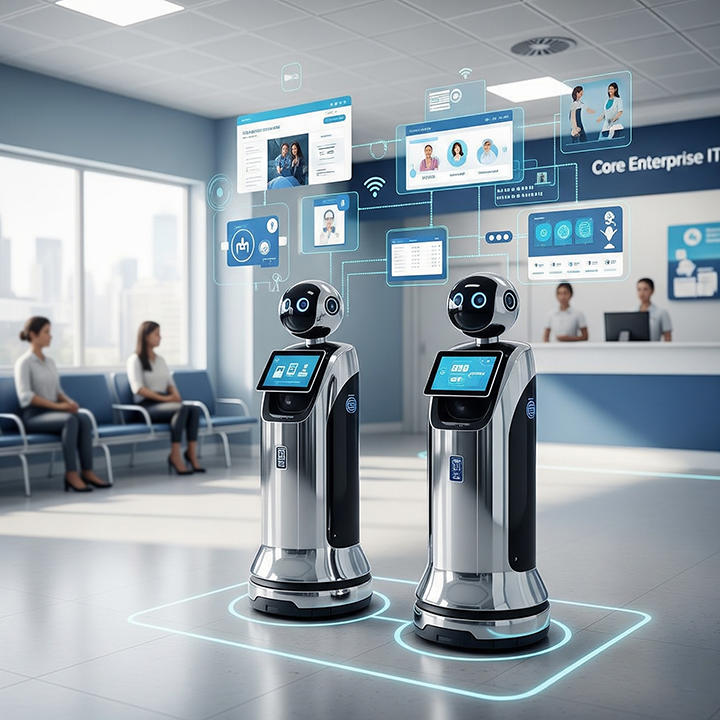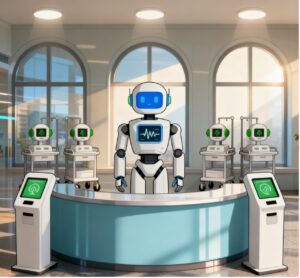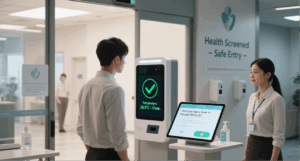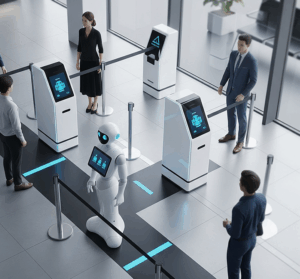
News & Updates

Robotics Integration in Customer Service Operations 2025
Robotics integration in customer service is transforming how businesses deliver exceptional experiences in 2025. From AI-powered queue assistance to automated visitor guidance, robotics solutions are eliminating operational bottlenecks whilst enhancing customer satisfaction across healthcare, government, and financial sectors. Smart robotics platforms like Q’Bot™ demonstrate how organisations can achieve seamless service automation without compromising the human touch. Modern service robotics don’t simply replace human interaction they amplify it, creating hybrid environments where technology handles routine processes whilst staff focus on complex problem-solving and relationship building. This strategic approach to automation is particularly relevant for organisations managing high-volume customer touchpoints, where consistency and efficiency directly impact reputation and operational costs. As digital transformation accelerates across sectors, robotics integration has evolved from experimental technology to essential infrastructure for forward-thinking organisations committed to delivering superior customer experiences.
Automated Queue Management and Customer Flow Optimisation
Robotics-powered queue management represents a fundamental shift from reactive to proactive customer service delivery. Advanced robotic systems now monitor customer flow patterns, predict peak periods, and automatically adjust service configurations to prevent congestion before it impacts the customer experience. These intelligent platforms integrate seamlessly with existing queue management infrastructure, providing real-time guidance and reducing average wait times by up to 40% across diverse operational environments. Healthcare facilities report particularly impressive results, with robotic queue assistants managing patient flow whilst providing essential health screening information and appointment confirmations.
Government service centres and banking institutions are deploying robotic assistants that can handle routine inquiries, direct customers to appropriate service points, and provide multilingual support throughout the customer journey. This automation frees human staff to focus on complex problem-solving and relationship management whilst ensuring consistent service quality regardless of volume fluctuations. The result is a more resilient service delivery model that maintains high standards even during unexpected demand surges or staffing challenges.
Real-Time Traffic Pattern Recognition
Robotic systems equipped with computer vision and sensor technology continuously analyse customer movement patterns, identifying potential bottlenecks before they impact service delivery. These platforms can detect when specific service counters are experiencing delays and automatically redirect incoming customers to alternative points with shorter wait times. Machine learning algorithms improve prediction accuracy over time, enabling organisations to maintain optimal flow even during unexpected demand surges. The integration of environmental sensors allows these systems to factor in external conditions such as weather patterns or local events that might influence customer volumes.
Multilingual Customer Guidance Systems
Modern service robots provide instant language support, breaking down communication barriers that traditionally slow customer processing. These systems can deliver instructions, answer frequently asked questions, and guide customers through complex procedures in multiple languages simultaneously. This capability is particularly valuable in diverse metropolitan areas where language diversity can significantly impact service efficiency and customer satisfaction. Advanced natural language processing ensures that cultural nuances and regional dialects are properly recognised and addressed, creating inclusive service environments that welcome all community members regardless of their linguistic background.
Self-Service Automation and Contactless Transaction Processing
Self-service robotics has evolved beyond simple kiosk interfaces to become sophisticated transaction processors capable of handling complex customer requests with remarkable precision and security. Modern robotic platforms can authenticate users, process payments, generate documentation, and complete multi-step procedures without human intervention whilst maintaining strict compliance with regulatory requirements. Financial institutions report 60% reductions in routine transaction processing times when deploying advanced self-service robotics, with customer satisfaction scores improving significantly due to reduced wait times and increased service availability.
These systems maintain strict security protocols whilst offering 24/7 availability, extending service hours without increasing operational costs or compromising data protection standards. Integration with mobile applications and cloud-based systems ensures data synchronisation across all customer touchpoints, creating seamless omnichannel experiences that meet contemporary expectations for speed and convenience. The result is a service ecosystem where customers can initiate transactions on one platform and complete them on another without data loss or process interruption. Advanced error handling capabilities ensure that even complex transactions are processed accurately, with automatic rollback procedures protecting both organisations and customers from processing errors.
Secure Biometric Authentication Processing
Advanced robotic systems incorporate multiple authentication methods including fingerprint scanning, facial recognition, and voice verification to ensure secure access to sensitive services. These platforms can verify customer identity within seconds whilst maintaining compliance with data protection regulations such as ISO/IEC 27001 standards. The integration of blockchain technology in some systems provides additional security layers, creating tamper-proof audit trails for high-value transactions that support regulatory compliance and fraud prevention initiatives.
Automated Document Generation and Processing
Service robots can now generate official documents, process applications, and handle complex paperwork requirements that previously required extensive human review and verification. These systems cross-reference multiple databases, verify information accuracy, and produce legally compliant documentation in real-time whilst maintaining detailed audit trails for compliance purposes. Government agencies utilising these capabilities report significant improvements in processing accuracy and dramatic reductions in administrative overhead costs, with some departments achieving complete automation of routine document processing workflows.
Multi-Channel Payment Integration
Robotic payment processors support diverse payment methods including contactless cards, mobile wallets, cryptocurrency, and traditional cash handling through sophisticated validation and reconciliation systems. These platforms automatically reconcile transactions across multiple channels whilst providing instant receipts and confirmation messages through customers’ preferred communication channels. Advanced fraud detection algorithms monitor transaction patterns to identify suspicious activity and protect both organisations and customers from financial risks, with machine learning capabilities that adapt to emerging threat patterns in real-time.
Predictive Analytics and Resource Allocation Intelligence
Intelligent robotics platforms generate vast amounts of operational data that, when processed through advanced analytics engines, provide unprecedented insights into customer behaviour and service demand patterns. These systems can predict staffing requirements, anticipate equipment maintenance needs, and recommend operational adjustments weeks in advance based on comprehensive data analysis and machine learning algorithms. Retail chains using predictive robotics report 25% improvements in resource allocation efficiency and 30% reductions in customer complaints related to service availability, demonstrating the tangible benefits of data-driven operational management.
Machine learning algorithms continuously refine prediction models based on historical data, seasonal trends, and external factors such as local events or economic indicators, enabling organisations to maintain optimal service levels whilst minimising operational costs. The sophistication of these predictive capabilities allows for scenario planning and contingency management that would be impossible with traditional manual approaches. Integration with external data sources such as weather forecasts, traffic patterns, and social media sentiment analysis further enhances prediction accuracy, creating comprehensive intelligence platforms that support strategic decision-making across all levels of the organisation.
Dynamic Staff Allocation Recommendations
AI-powered robotics analyse historical traffic patterns, current queue lengths, and scheduled appointments to generate precise staffing recommendations for different time periods throughout the day and week. These systems can predict when additional personnel will be needed and suggest optimal deployment strategies to maintain service level agreements whilst minimising labour costs. Organisations implementing these recommendations experience significantly improved staff utilisation rates and reduced overtime costs, with some facilities achieving optimal staffing levels that improve both employee satisfaction and customer service outcomes.
Preventive Maintenance Scheduling
Robotic systems monitor equipment performance metrics and environmental conditions to predict when maintenance interventions will be required, transforming reactive maintenance approaches into proactive asset management strategies. This proactive approach prevents service disruptions caused by equipment failures whilst optimising maintenance schedules to minimise operational impact on customer service delivery. Facility managers receive detailed reports highlighting potential issues before they affect customer service delivery, enabling cost-effective preventive measures rather than expensive emergency repairs that could disrupt operations and damage customer relationships.
Enhanced Security and Compliance Monitoring
Robotics integration significantly strengthens security protocols and compliance monitoring capabilities across customer service environments, creating comprehensive security ecosystems that protect both customers and organisations. Advanced robotic systems can continuously monitor premises for security threats, verify visitor credentials, and maintain comprehensive audit trails for regulatory compliance without creating friction in the customer experience. Healthcare organisations using robotic security systems report 45% improvements in compliance audit scores and 50% reductions in security incidents, demonstrating the effectiveness of automated security protocols in high-stakes environments.
These platforms integrate seamlessly with existing access control systems, surveillance networks, and emergency response protocols to create comprehensive security ecosystems that respond intelligently to varying threat levels. Automated threat detection algorithms can identify suspicious behaviour patterns and trigger appropriate responses without human intervention, ensuring consistent security standards regardless of staff availability or expertise levels. The result is a security framework that adapts to changing conditions whilst maintaining the highest standards of customer service and regulatory compliance. Advanced machine learning capabilities enable these systems to distinguish between genuine security concerns and false alarms, reducing unnecessary interventions whilst maintaining vigilant protection.
Automated Visitor Verification and Tracking
Robotic security systems can verify visitor identification, cross-reference appointment schedules, and track movement throughout facilities in real-time whilst respecting privacy requirements and maintaining customer comfort. These platforms maintain detailed logs of all visitor interactions whilst ensuring compliance with privacy regulations such as data protection acts and sector-specific confidentiality requirements. Emergency evacuation procedures are enhanced through precise visitor location tracking, enabling rapid headcount verification and ensuring comprehensive safety protocols during critical situations without compromising day-to-day operational efficiency.
Continuous Compliance Monitoring and Reporting
Advanced robotics platforms automatically monitor service delivery against regulatory requirements, generating detailed compliance reports for audit purposes whilst identifying potential issues before they become violations. These systems can identify potential compliance violations before they occur and recommend corrective actions to maintain regulatory standards across all operational areas. Automated documentation ensures that all customer interactions are properly recorded and easily retrievable for regulatory review or legal proceedings, supporting organisational accountability and transparency in all customer service activities.
Personalised Customer Experience and Engagement
Modern service robotics deliver highly personalised customer experiences by leveraging comprehensive customer data and sophisticated interaction algorithms that create meaningful, contextual engagements. These systems can recognise returning customers, recall previous interactions, and proactively address individual preferences and requirements without compromising privacy or creating intrusive experiences. Educational institutions deploying personalised service robots report 70% increases in student satisfaction scores and 40% reductions in service-related inquiries, demonstrating the effectiveness of personalised automation in complex service environments.
Advanced natural language processing enables robots to engage in contextual conversations, understand emotional cues, and adapt communication styles to individual customer preferences whilst maintaining professional service standards. Integration with CRM systems ensures that robotic interactions are seamlessly coordinated with human staff touchpoints, creating cohesive customer journeys that feel both efficient and genuinely attentive to individual needs. The sophistication of these personalisation engines extends beyond simple preference recognition to include predictive service recommendations and proactive problem resolution that anticipates customer needs before they are explicitly expressed.
Contextual Conversation Management
AI-powered dialogue systems enable robots to engage in meaningful conversations that go beyond scripted responses, incorporating contextual awareness and emotional intelligence to create natural interactions. These platforms can understand context, remember previous interactions, and adapt their communication approach based on customer personality profiles and current emotional states derived from voice analysis and interaction patterns. Advanced sentiment analysis ensures that robots can escalate complex or sensitive situations to human staff when appropriate, maintaining service quality whilst maximising automation efficiency and ensuring that customers always receive appropriate support for their specific circumstances.
Proactive Service Recommendations
Intelligent robotics platforms can analyse customer history and current context to proactively suggest relevant services or process improvements that enhance the overall customer experience. These systems might recommend faster service routes, suggest alternative appointment times, or highlight additional services that align with customer needs and preferences based on comprehensive data analysis. This proactive approach transforms routine service interactions into value-added experiences that strengthen customer loyalty and drive business growth whilst positioning organisations as genuinely customer-focused and forward-thinking in their service delivery approach.
Robotics integration represents more than technological advancement it embodies a strategic commitment to operational excellence and customer-centric innovation that positions organisations for sustained competitive advantage. Organisations implementing comprehensive robotics solutions achieve measurable improvements in efficiency, security, and customer satisfaction whilst positioning themselves for future digital transformation initiatives that will define market leadership in coming years. As customer expectations continue to evolve towards greater convenience, personalisation, and accessibility, robotics integration provides the foundation for sustainable competitive advantage in an increasingly automated service landscape. ATT InfoSoft’s robotics-enabled solutions, including the innovative Q’Bot™ platform and comprehensive enterprise systems, demonstrate how thoughtful technology integration can transform customer service operations without sacrificing the human elements that customers value most. Contact ATT InfoSoft today to explore how our proven robotics solutions can elevate your customer service operations and deliver measurable improvements in efficiency, satisfaction, and competitive positioning.
Contact ATT at infosoft-sales@attsystemsgroup.com for details.
Frequently Asked Questions (FAQ)
Q: How are robotics platforms like Q’Bot™ improving customer flow in high-traffic environments?
A: Platforms like Q’Bot™ use real-time monitoring and AI to predict peak periods and dynamically direct customers, reducing wait times and congestion by up to 40%.
Q: What security benefits does robotics integration bring to customer service operations?
A: Robotics enhance security by automating visitor verification, monitoring for threats, and maintaining detailed audit trails to support compliance without disrupting the customer experience.
Q: Can service robots handle multilingual customer interactions effectively?
A: Yes, modern service robots use advanced natural language processing to guide and assist customers in multiple languages, improving accessibility and satisfaction in diverse environments.
Q: How does robotics integration affect staff roles in customer service?
A: Robotics handle routine and repetitive tasks, allowing human staff to focus on complex issues and building stronger customer relationships.
Q: Are self-service robotics secure enough for processing sensitive transactions in sectors like banking?
A: Absolutely; these robots use biometric authentication, encrypted data handling, and advanced fraud detection to ensure transaction security and regulatory compliance.
Q: How does predictive analytics in robotics help with resource allocation?
A: Robotics platforms analyse historical and real-time data to anticipate demand, enabling smarter scheduling and resource allocation for optimal service and cost efficiency.
Q: What makes ATT InfoSoft’s Q’Bot™ stand out for organisations looking to integrate robotics?
A: ATT InfoSoft’s Q’Bot™ offers seamless automation, advanced personalisation, and robust security features, delivering measurable improvements in efficiency and customer satisfaction without losing the human touch.
Contact ATT at infosoft-sales@attsystemsgroup.com for details.
Send us a message
Contact Information
Address:
35 Ubi Crescent, ATT Building, Singapore, 408585
Phone:
Email:
Website:
www.attsystemsgroup.com







